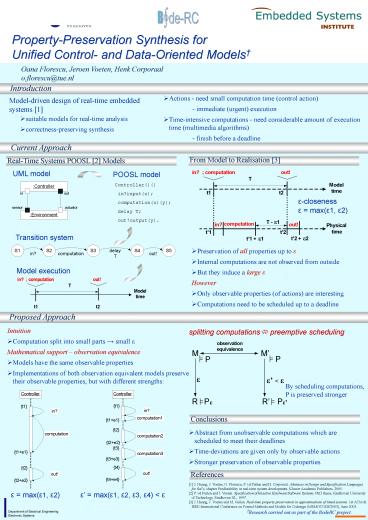Property-Preservation Synthesis for Unified Control- and Data-Oriented Models - PowerPoint PPT Presentation
1 / 1
Title:
Property-Preservation Synthesis for Unified Control- and Data-Oriented Models
Description:
Property-Preservation Synthesis for Unified Control- and Data-Oriented Models Oana Florescu, Jeroen Voeten, Henk Corporaal o.florescu_at_tue.nl – PowerPoint PPT presentation
Number of Views:19
Avg rating:3.0/5.0
Title: Property-Preservation Synthesis for Unified Control- and Data-Oriented Models
1
Property-Preservation Synthesis for Unified
Control- and Data-Oriented Models
Oana Florescu, Jeroen Voeten, Henk
Corporaal o.florescu_at_tue.nl
Introduction
- Actions - need small computation time (control
action) - - immediate (urgent) execution
- Time-intensive computations - need considerable
amount of execution time (multimedia algorithms) - - finish before a deadline
Model-driven design of real-time embedded systems
1
- suitable models for real-time analysis
- correctness-preserving synthesis
Current Approach
From Model to Realisation 3
Real-Time Systems POOSL 2 Models
UML model
POOSL model
Controller()() in?input(x) computation(x)(y)
delay T out!output(y).
e-closeness e max(e1, e2)
Transition system
- Preservation of all properties up to e
- Internal computations are not observed from
outside - But they induce a large e
- However
- Only observable properties (of actions) are
interesting - Computations need to be scheduled up to a deadline
Model execution
Proposed Approach
- Intuition
- Computation split into small parts ? small e
- Mathematical support observation equivalence
- Models have the same observable properties
- Implementations of both observation equivalent
models preserve their observable properties, but
with different strengths
splitting computations? preemptive scheduling
By scheduling computations, P is preserved
stronger
Conclusions
- Abstract from unobservable computations which are
scheduled to meet their deadlines - Time-deviations are given only by observable
actions - Stronger preservation of observable properties
References
1 J. Huang, J. Voeten, O. Florescu, P. vd
Putten and H. Corporaal. Advances in Design and
Specification Languages for SoCs, chapter
Predictability in real-time system development.
Kluwer Academic Publishers, 2005. 2 P. vd
Putten and J. Voeten. Specification of Reactive
Hardware/Software Systems. PhD thesis, Eindhoven
University of Technology, Eindhoven NL, 1997. 3
J. Huang, J. Voeten and M. Geilen. Real-time
property preservation in approximations of timed
systems. 1st ACM IEEE International Conference
on Formal Methods and Models for Codesign
(MEMOCODE'2003), June 2003.
e max(e1, e2)
e max(e1, e2, e3, e4) lt e
Research carried out as part of the BodeRC
project.
Department of Electrical Engineering Electronic
Systems































